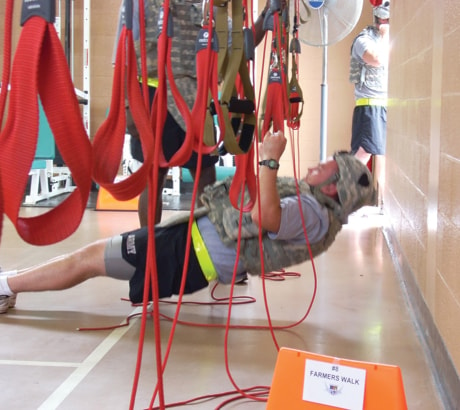At Army bases throughout the U.S., an early-morning regimen has been repeated the same way for generations. Troops assemble at oh-dark-30 — that’s “early,” in military talk — first for calisthenics (heavy on pushups and sit-ups), then for a run in formation.
But thanks to Dr. Scott Lephart and his team at the Neuromuscular Research Laboratory (NMRL) at the Department of Sports Medicine and Nutrition at the University of Pittsburgh Medical Center, that’s changing radically at Fort Campbell, Ky., home of the 101st Airborne Division, and likely soon will change throughout the Army.
For years, researchers at the lab have helped elite athletes such as the NFL’s Steelers and the NHL’s Penguins improve their performance and reduce the risk of injury.
Three years ago, the commanding general of the 101st asked UPMC’s help in reducing the number of injuries his soldiers were suffering in training. Soldiers in the 101st Airborne go through a grueling two-week Air Assault course, which features intense physical activity and a great deal of rappelling from helicopters. In the typical course, 53 per cent of students suffered musculo-skeletal injuries.
Lephart and his team built a clone of their lab at a gym at Fort Campbell, and they followed soldiers out into the field.
“We put oxygen masks on soldiers in the field to test the demands on them in simulated combat,” Lephart said.
Their findings are revolutionizing the way the Army conducts physical training. Out are the group calisthenics. In are drills that address the specific deficiencies the NMRL team found in 101st Airborne soldiers, and the specific physical demands combat is likely to place on them.
These drills resemble more the workouts professional athletes have in the off-season than traditional military physical training. They emphasize speed, agility, balance, reaction, quickness and endurance.
“The strength exercises are very specific to the functions (soldiers) are going to do, like lifting ammo cans,” Lephart said.
The balance exercises the soldiers are doing will be especially important in Afghanistan, where the 101st is scheduled to deploy next year, because “the terrain is so bad,” Lephart said.
In many of the drills, soldiers wear their helmet and body armour, as they would in combat.
Working out in combat gear is important because its weight alters lower-extremity joint positions, and increases landing forces by 25 per cent when running or jumping, Lephart said.
Nutritional counseling is also important, Lephart said, because the NMRL found that 72 per cent of the soldiers they tested were overweight compared to the military ideal.
“Not only were they eating too much fast food, they weren’t getting the right kind of nutrients they need to replace all the energy they were expending in training,” he said.
Soldiers in a company trained on the eight-week exercise program devised by the NMRL team scored 30 per cent better on the Army’s physical-fitness test than a control company that conducted physical training the old-fashioned way.
When Maj. Gen. Jeffrey Schloesser, then the commander of the 101st Airborne Division, was briefed on the test results, he ordered that the new training program be implemented throughout the division.
To get the program going, NMRL researchers have created a five-day training program for the noncommissioned officers from each platoon within the division who will act as instructors.
“First we have them experience the program,” Lephart said. “Then we go into the classroom to explain to them why the program is constructed the way it is.”
Enthusiasm for the NMRL’s research extends beyond Fort Campbell.
“I’m excited about what the University of Pittsburgh is doing for us,” Gen. Peter Chiarelli, the vice chief of staff of the Army, told a House committee earlier in the year.
The NMRL team already is working with the Navy’s SEALs.
NMRL’s work with the 101st will continue even when the division deploys to Afghanistan.
“The beauty of this program is it’s 100 per cent deployable,” Lephart said. “A single duffel bag can contain all the stuff you need for it.”
The focus will be on injury prevention. Soldiers in Afghanistan have been suffering many non-combat injuries as a result of the heavy loads they have to carry in the rough terrain and high altitude of Afghanistan.
“Physical conditioning, and, what we’re finding through the University of Pittsburgh study that’s being conducted, nutrition are key elements in helping soldiers when they have to carry these loads in avoiding the kind of muscular-skeletal injuries that we are seeing today,” Chiarelli told the House Defense Appropriations Subcommittee.
